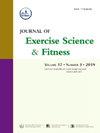无器械、低强度、高强度间歇训练在改善不运动男性身心健康方面的实际效果:一项随机对照试验
IF 2.4
2区 医学
Q2 SPORT SCIENCES
引用次数: 0
摘要
目的:虽然减少运动强度的高强度间歇训练(REHIT)对健康有益,但大多数支持性证据来自依赖专业设备的实验室研究。这项研究考察了在久坐不动的年轻人中使用立卧撑(BIT)进行无器械REHIT的实际效果。方法一项为期12周的随机对照试验(n = 319名无运动的男性,年龄20.5±1.1岁,最大摄氧量[VO2max] 37.7±1.4 ml/min/kg)比较了四个队列:有监督的BIT (n = 79),现实条件下无监督的BIT (BIT- rw;n = 79),有监督的自行车冲刺间歇训练(SIT;n = 82),以及一个不行使权力的对照组(CON;n = 79)。运动组每周进行3-5次2 × 20秒的全力以赴训练。在整个干预过程中监测训练和情感反应。干预前后的结局包括身体组成、心肺健康和心理健康(压力、抑郁、焦虑、睡眠质量、恢复力和与健康相关的生活质量[QoL])。结果有监督的BIT达到最大心率(HRmax)的91% - 94%,而BIT- rw的HRmax为90%。所有运动组均表现出显著的生理改善:体重减少6% - 8%,最大摄氧量增加8% - 13% (η2p = 0.7-0.8, p <;0.001)。此外,运动训练可以显著减少压力(49% - 61%,p <;0.001),焦虑(37 - 86%,p <;0.001),抑郁症(14 - 48%,p <;0.001),以及恢复力的改善(22 - 27%,p <;0.001)和生活质量(14 - 27%,p <;0.001)。在VO2max增益方面,BIT- rw与SIT相匹配(5.0±0.6 ml/min/kg),而BIT- rw表现出较小的生理益处(3.0±0.6 ml/min/kg),但情感反应的改善程度高出10% (p <;0.05)。本研究表明,即使在无人监督的自由生活环境中实施,使用立卧撑的40-s无器械REHIT方案也能改善身心健康结果。这些发现表明,对于那些受到设备或专业监督限制的个人来说,BIT是一种方便且省时的培训选择。本文章由计算机程序翻译,如有差异,请以英文原文为准。
Real-world efficacy of equipment-free reduced-exertion high-intensity interval training in improving physical and mental health in inactive males: A randomized controlled trial
Aim
Although reduced-exertion high-intensity interval training (REHIT) confers well-documented health benefits, most supporting evidence derives from laboratory studies that rely on specialized equipment. This study examined the real-world efficacy of equipment-free REHIT using burpees (BIT) in sedentary young adults.
Methods
A 12-week randomized controlled trial (n = 319 inactive men, age 20.5 ± 1.1 years, maximal oxygen uptake [VO2max] 37.7 ± 1.4 ml/min/kg) compared four cohorts: supervised BIT (n = 79), unsupervised BIT in real-world conditions (BIT-RW; n = 79), supervised cycling-based sprint interval training (SIT; n = 82), and a non-exercising control (CON; n = 79). Exercise groups performed 2 × 20s all-out effort sessions 3–5 times weekly. Training and affective responses were monitored throughout the intervention. Pre- and post-intervention outcomes included body composition, cardiorespiratory fitness, and mental health (stress, depression, anxiety, sleep quality, resilience, and health-related quality of life [QoL]).
Results
The supervised BIT achieved 91 %–94 % of maximal heart rate (HRmax), compared to ∼90 % HRmax in BIT-RW. All exercise groups exhibited significant physiological improvements: 6 %–8 % body mass reduction, 8 %–13 % VO2max increase (η2p = 0.7–0.8, p < 0.001). Additionally, exercise training resulted in significant reductions in stress (49–61 %, p < 0.001), anxiety (37–86 %, p < 0.001), depression (14–48 %, p < 0.001), as well as improvements in resilience (22–27 %, p < 0.001) and QoL (14–27 %, p < 0.001). Supervised BIT matched SIT in VO2max gains (5.0 ± 0.6 ml/min/kg), while BIT-RW showed smaller physiological benefits (3.0 ± 0.6 ml/min/kg) but 10 % greater improvements in affective responses (p < 0.05).
Conclusions
This study demonstrates that a 40-s equipment-free REHIT protocol utilizing burpees improves both physical and mental health outcomes, even when implemented in unsupervised free-living settings. These findings suggest that BIT is an accessible and time-efficient training option for individuals constrained by limited access to equipment or professional oversight.
求助全文
通过发布文献求助,成功后即可免费获取论文全文。
去求助
来源期刊
CiteScore
5.10
自引率
3.60%
发文量
54
审稿时长
31 days
期刊介绍:
The Journal of Exercise Science and Fitness is the official peer-reviewed journal of The Society of Chinese Scholars on Exercise Physiology and Fitness (SCSEPF), the Physical Fitness Association of Hong Kong, China (HKPFA), and the Hong Kong Association of Sports Medicine and Sports Science (HKASMSS). It is published twice a year, in June and December, by Elsevier.
The Journal accepts original investigations, comprehensive reviews, case studies and short communications on current topics in exercise science, physical fitness and physical education.

 求助内容:
求助内容: 应助结果提醒方式:
应助结果提醒方式:


